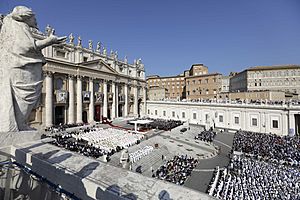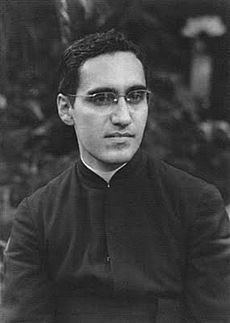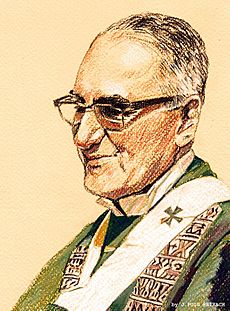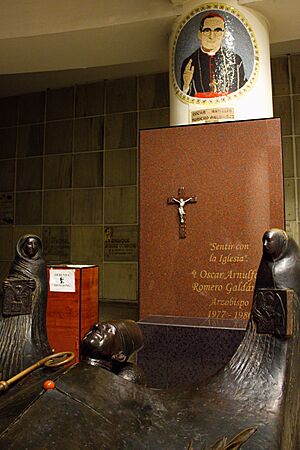Óscar Romero facts for kids
Quick facts for kids Óscar Romero |
|
|---|---|
| Archbishop of San Salvador | |
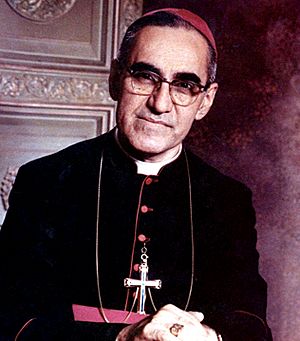
Romero in 1978 on a visit to Rome
|
|
| Church | Catholic Church |
| Archdiocese | San Salvador |
| Appointed | 3 February 1977 |
| Enthroned | 22 February 1977 |
| Reign ended | 24 March 1980 |
| Predecessor | Luis Chávez y González |
| Successor | Arturo Rivera y Damas |
| Other posts |
|
| Orders | |
| Ordination | 4 April 1942 |
| Consecration | 25 April 1970 by Girolamo Prigione |
| Personal details | |
| Birth name | Óscar Arnulfo Romero y Galdámez |
| Born | 15 August 1917 Ciudad Barrios, San Miguel, El Salvador |
| Died | 24 March 1980 (aged 62) Chapel of Hospital de la Divina Providencia, San Salvador, El Salvador |
| Buried | Metropolitan Cathedral of San Salvador, San Salvador |
| Denomination | Catholicism |
| Signature | |
| Coat of arms | |
| Sainthood | |
| Feast day | 24 March |
| Venerated in |
|
| Beatified | 23 May 2015 Plaza El Salvador de Mundo, San Salvador, El Salvador by Angelo Amato, representing Pope Francis |
| Canonized | 14 October 2018 Saint Peter's Square, Vatican City by Pope Francis |
| Attributes | Episcopal vestments Crown of martyrdom Martyr's palm Rosary |
| Patronage |
|
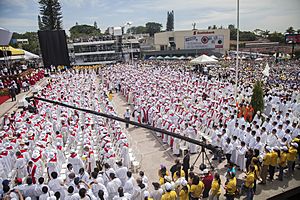
Óscar Arnulfo Romero y Galdámez (15 August 1917 – 24 March 1980) was a prelate of the Catholic Church in El Salvador. He served as Auxiliary Bishop of the Archdiocese of San Salvador, the Titular Bishop of Tambeae, as Bishop of Santiago de María, and finally as the fourth Archbishop of San Salvador. As archbishop, Romero spoke out against social injustice and violence amid the escalating conflict between the military government and left-wing insurgents that led to the Salvadoran Civil War. In 1980, Romero was killed by an assassin while celebrating Mass. Though no one was ever convicted for the crime, investigations by the UN-created Truth Commission for El Salvador concluded that Major Roberto D'Aubuisson, a death squad leader and later founder of the right-wing Nationalist Republican Alliance (ARENA) political party, had ordered the killing.
In 1997, Pope John Paul II bestowed upon Romero the title of Servant of God, and a cause for his beatification was opened by the church. The cause stalled but was reopened by Pope Benedict XVI in 2012. Romero was declared a martyr by Pope Francis on 3 February 2015, paving the way for his beatification on 23 May 2015. During Romero's beatification, Pope Francis declared that his "ministry was distinguished by his particular attention to the most poor and marginalized." Pope Francis canonized Romero on 14 October 2018.
Seen as a social conservative at the time of his appointment as archbishop in 1977, Romero was deeply affected by the murder of his friend and fellow priest Rutilio Grande and thereafter became an outspoken critic of the military government of El Salvador. Hailed by supporters of liberation theology, Romero, according to his biographer, "was not interested in liberation theology" but faithfully adhered to Catholic teachings on liberation and a preferential option for the poor, desiring a social revolution based on interior reform. Up to the end of his life, his spiritual life drew much from the spirituality of Opus Dei.
In 2010, the United Nations General Assembly proclaimed 24 March as the "International Day for the Right to the Truth Concerning Gross Human Rights Violations and for the Dignity of Victims" in recognition of Romero's role in defence of human rights. Romero actively denounced violations of the human rights of the most vulnerable people and defended the principles of protecting lives, promoting human dignity and opposing all forms of violence. Archbishop José Luis Escobar Alas, one of Romero's successors as Archbishop of San Salvador, asked Pope Francis to proclaim Romero a Doctor of the Church, which is an acknowledgement from the church that his religious teachings were orthodox and had a significant impact on its philosophy and theology.
Latin American church groups often proclaim Romero an unofficial patron saint of the Americas and El Salvador; Catholics in El Salvador often refer to him as San Romero, as well as Monseñor Romero. Outside of Catholicism, Romero is honoured by other Christian denominations, including the Church of England and Anglican Communion, through the Calendar in Common Worship, as well as in at least one Lutheran liturgical calendar. Romero is also one of the ten 20th-century martyrs depicted in statues above the Great West Door of Westminster Abbey in London.
Contents
Early life
Óscar Romero was born on 15 August 1917 to Santos Romero and Guadalupe de Jesús Galdámez in Ciudad Barrios in the San Miguel department of El Salvador. On 11 May 1919, at the age of one, Romero was baptized into the Catholic Church by the priest Cecilio Morales.
Romero entered the local public school, which offered only grades one through three. When finished with public school, Romero was privately tutored by a teacher, Anita Iglesias, until the age of thirteen. During this time Romero's father trained him in carpentry. Romero showed exceptional proficiency as an apprentice. His father wanted to offer his son the skill of a trade, because in El Salvador studies seldom led to employment, however, Romero broached the idea of studying for the priesthood, which did not surprise those who knew him.
Priesthood
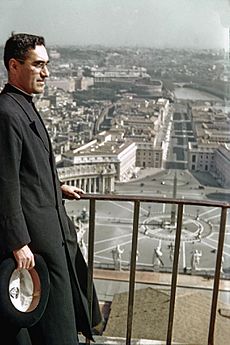
Romero entered the minor seminary in San Miguel at the age of thirteen. He left the seminary for three months to return home when his mother became ill after the birth of her eighth child; during this time he worked with two of his brothers in a gold mine near Ciudad Barrios. After graduation, he enrolled in the national seminary in San Salvador. He completed his studies at the Gregorian University in Rome, where he received a Licentiate in Theology cum laude in 1941, but had to wait a year to be ordained because he was younger than the required age. He was ordained in Rome on 4 April 1942. His family could not attend his ordination because of travel restrictions due to World War II. Romero remained in Italy to obtain a doctoral degree in theology, specializing in ascetical theology and Christian perfection according to Luis de la Puente. Before finishing, in 1943 at the age of 26, he was summoned back home from Italy by his bishop. He traveled home with a good friend, Father Valladares, who was also doing doctoral work in Rome. On the route home, they made stops in Spain and Cuba, where they were detained by the Cuban police, likely for having come from Fascist Italy, and were placed in a series of internment camps. After several months in prison, Valladares became sick and Redemptorist priests helped to have the two transferred to a hospital. From the hospital they were released from Cuban custody and sailed on to Mexico, then traveled overland to El Salvador.
Romero was first assigned to serve as a parish priest in Anamorós, but then moved to San Miguel where he worked for over 20 years. He promoted various apostolic groups, started an Alcoholics Anonymous group, helped in the construction of San Miguel's cathedral, and supported devotion to Our Lady of Peace. He was later appointed rector of the inter-diocesan seminary in San Salvador. Emotionally and physically exhausted by his work in San Miguel, Romero took a retreat in January 1966 where he visited a priest for confession and a psychiatrist. He was diagnosed by the psychiatrist as having obsessive-compulsive personality disorder and by priests with scrupulosity.
In 1966, he was chosen to be Secretary of the Bishops Conference for El Salvador. He also became the director of the archdiocesan newspaper Orientación, which became fairly conservative while he was editor, defending the traditional Magisterium of the Catholic Church.
Bishop and Archbishop

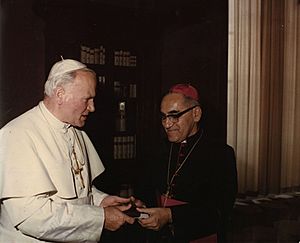
On 25 April 1970, Romero was appointed an auxiliary bishop for the Archdiocese of San Salvador and as the titular bishop of Tambeae. He was consecrated on 21 June by Girolamo Prigione, titular Archbishop of Lauriacum. On 15 October 1974, he was appointed Bishop of the Diocese of Santiago de María, a poor, rural region.
On 3 February 1977, Romero was appointed Archbishop of San Salvador, assuming the position on 22 February.
On 15 October 1979, the Revolutionary Government Junta (JRG) came to power amidst a wave of human rights abuses by paramilitary right-wing groups and the government, in an escalation of violence that would become the Salvadoran Civil War. Romero criticized the United States for giving military aid to the new government and wrote an open letter to President Jimmy Carter in February 1980, warning that increased US military aid would "undoubtedly sharpen the injustice and the political repression inflicted on the organized people, whose struggle has often been for their most basic human rights." This letter was then sent, via telegram, from the U.S. embassy in El Salvador to Washington D.C. Carter did not directly respond to the letter; instead, Cyrus Vance, the Secretary of State, wrote a telegram back to the U.S. embassy. The telegram carried a very contradictory message, both stating that the United States will not interfere but will respond to the Revolutionary Government Junta's requests. It is unknown if Archbishop Romero received the telegram.
On 11 May 1979, Romero met with Pope John Paul II and unsuccessfully attempted to obtain a Vatican condemnation of the Salvadoran military regime for committing human rights violations and its support of death squads, and expressed his frustration in working with clergy who cooperated with the government. He was encouraged by Pope John Paul II to maintain episcopal unity as a top priority.
As a result of his humanitarian efforts, Romero began to be noticed internationally. In February 1980, he was given an honorary doctorate by the Catholic University of Louvain.
Assassination
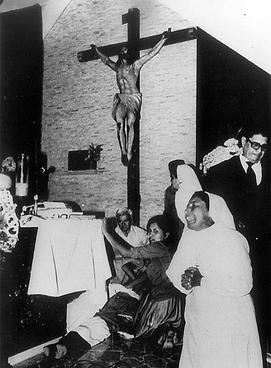
On 23 March 1980, Archbishop Romero delivered a sermon in which he called on Salvadoran soldiers, as Christians, to obey God's higher order and to stop carrying out the government's repression and violations of basic human rights.
Romero spent 24 March in a recollection organized by Opus Dei, a monthly gathering of priest friends led by Fernando Sáenz Lacalle. On that day they reflected on the priesthood. That evening, Romero celebrated Mass at a small chapel at Hospital de la Divina Providencia (Divine Providence Hospital), a church-run hospital specializing in oncology and care for the terminally ill. Romero finished his sermon, stepped away from the lectern, and took a few steps to stand at the center of the altar.
As Romero finished speaking, a red car came to a stop on the street in front of the chapel. A gunman emerged from the vehicle, stepped to the door of the chapel, and fired one, or possibly two, shots. Romero was struck in the heart, and the vehicle sped off. He died at the Chapel of Hospital de la Divina Providencia in San Salvador.
Funeral
Romero was buried in the Metropolitan Cathedral of San Salvador. The Funeral Mass on 30 March 1980 in San Salvador was attended by more than 250,000 mourners from all over the world. Viewing this attendance as a protest, Jesuit priest John Dear has said, "Romero's funeral was the largest demonstration in Salvadoran history, some say in the history of Latin America."
At the funeral, Cardinal Ernesto Corripio y Ahumada, speaking as the personal delegate of Pope John Paul II, eulogized Romero as a "beloved, peacemaking man of God," and stated that "his blood will give fruit to brotherhood, love and peace."
Legacy
International recognition
During his first visit to El Salvador in 1983, Pope John Paul II entered the cathedral in San Salvador and prayed at Romero's tomb, despite opposition from the government and from some within the church who strongly opposed liberation theology. Afterwards, the Pope praised Romero as a "zealous and venerated pastor who tried to stop violence." John Paul II also asked for dialogue between the government and opposition to end El Salvador's civil war.
On 7 May 2000, in Rome's Colosseum during the Jubilee Year celebrations, Pope John Paul II commemorated 20th-century martyrs. Of the several categories of martyrs, the seventh consisted of Christians who were killed for defending their brethren in the Americas. Despite the opposition of some social conservatives within the church, John Paul II insisted that Romero be included. He asked the organizers of the event to proclaim Romero "that great witness of the Gospel."
On 21 December 2010, the United Nations General Assembly proclaimed 24 March as the International Day for the Right to the Truth concerning Gross Human Rights Violations and for the Dignity of Victims which recognizes, in particular, the important work and values of Romero.
On 22 March 2011, U.S. President Barack Obama visited Romero's tomb during an official visit to El Salvador. Irish President Michael D. Higgins visited the cathedral and tomb of Romero on 25 October 2013 during a state visit to El Salvador. Famed linguist Noam Chomsky speaks highly of Romero's social work, and refers often to his murder. In 2014, El Salvador's main international airport was named after him, becoming Monseñor Óscar Arnulfo Romero y Galdámez International Airport, and later, San Óscar Arnulfo Romero y Galdámez International Airport in 2018 after his canonization.
Romero is remembered in the Church of England and in the Episcopal Church on 24 March.
See also
 In Spanish: Óscar Arnulfo Romero para niños
In Spanish: Óscar Arnulfo Romero para niños
- List of peace activists
- List of unsolved murders
- Misa Campesina Nicaragüense
- Stanley Rother
- Salvadoran Civil War
- Rutilio Grande: assassinated 12 March 1977
- Alfonso Navarro: assassinated 11 May 1977
- Ernesto Barrera: assassinated 28 November 1978
- Octavio Ortiz: assassinated 20 January 1979
- Rafael Palacios: assassinated 20 June 1979
- Napoleón Macías: assassinated 4 August 1979
- Ignacio Martín-Baró: assassinated 16 November 1989
- Segundo Montes: assassinated 16 November 1989
- Ignacio Ellacuría: assassinated 16 November 1989
- Maura Clarke, Maryknoll
- Jean Donovan, lay missionary
- Ita Ford, Maryknoll
- Dorothy Kazel, Ursuline nun



